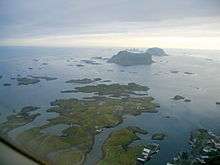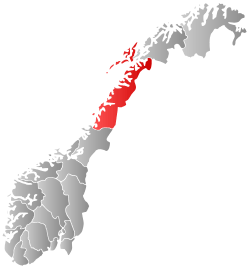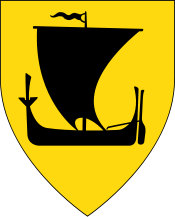Røst
| Røst kommune | |||
|---|---|---|---|
| Municipality | |||
| |||
 Røst within Nordland | |||
| Coordinates: 67°31′12″N 12°5′56″E / 67.52000°N 12.09889°ECoordinates: 67°31′12″N 12°5′56″E / 67.52000°N 12.09889°E | |||
| Country | Norway | ||
| County | Nordland | ||
| District | Lofoten | ||
| Administrative centre | Røst | ||
| Government | |||
| • Mayor (2011) | Tor-Arne Andreassen (Ap) | ||
| Area | |||
| • Total | 10.46 km2 (4.04 sq mi) | ||
| • Land | 10.13 km2 (3.91 sq mi) | ||
| • Water | 0.33 km2 (0.13 sq mi) | ||
| Area rank | 430 in Norway | ||
| Population (2011) | |||
| • Total | 605 | ||
| • Rank | 421 in Norway | ||
| • Density | 59.7/km2 (155/sq mi) | ||
| • Change (10 years) | -7.2 % | ||
| Demonym(s) | Røstværing[1] | ||
| Time zone | CET (UTC+1) | ||
| • Summer (DST) | CEST (UTC+2) | ||
| ISO 3166 code | NO-1856 | ||
| Official language form | Bokmål | ||
| Website |
www | ||
|
| |||
Røst is a municipality in Nordland county, Norway. It is part of the traditional district of Lofoten. The administrative centre of the municipality is the village of Røstlandet.
General information

The municipality of Røst was established on 1 July 1928 when it was separated from the municipality of Værøy. Initially, it had 731 residents. The municipal boundaries have not changed since that time.[2]
Name
The municipality is named after the main island of Røstlandet (Old Norse: Rǫst). The name is identical with the word rǫst which means "maelstrom". (See Moskstraumen.)[3]
Coat-of-arms
The coat-of-arms is from modern times; they were granted on 28 November 1986. The artist was Arvid Sveen. The arms show three black shags (Phalacrocorax aristotelis) on a grey background. The shags play a role in a local legend in which three brothers can transform themselves into shags.[4]
Churches
The Church of Norway has one parish (sokn) within the municipality of Røst. It is part of the Bodø deanery in the Diocese of Sør-Hålogaland.
| Parish (Sokn) | Church Name | Location of the Church | Year Built |
|---|---|---|---|
| Røst | Røst Church | Røstlandet | 1899 |
History
A vivid description of medieval island life has been delivered by the shipwrecked Venetian sea captain Pietro Querini, who was rescued by the islanders in 1432. He described the society as very harmonious and pious, and described how they made a living from fishing cod and some agriculture. The Norwegian Lundehund originated from this part of Norway, where it natively would have climbed along cliff paths to hunt puffins. Fishing is the main economic activity on Røst.
Culture
The island has a rich cultural life. Every year in June there is a popular festvial in honor of the puffin (Lundefestivalen)
Querini opera
In 2012 the Querini Opera was shown on Røst for the first time, telling the dramatic story about Pietro Querini who shipwrecked on Røst in 1432. The show was a great success and was shown again in 2014.
Government
All municipalities in Norway, including Røst, are responsible for primary education (through 10th grade), outpatient health services, senior citizen services, unemployment and other social services, zoning, economic development, and municipal roads. The municipality is governed by a municipal council of elected representatives, which in turn elect a mayor.
Municipal council
The municipal council (Kommunestyre) of Røst is made up of 11 representatives that are elected to every four years. Currently, the party breakdown is as follows:[5]
| Party Name | Name in Norwegian | Number of representatives | |
|---|---|---|---|
| Local Lists | Lokale lister | 11 | |
| Total number of members: | 11 | ||
Transportation

As an isolated island municipality, there are no road connections to Røst. It can be reached by boat and airplane. There are ferry connections to neighboring Værøy and also to the town of Bodø on the mainland. Røst Airport has regularly scheduled flights to Bodø.
Economy
During the winter, the population of Røst gets doubled due to the number of boats arriving at Røst to fish. Yearly, the small island of Røst produces fish and fish-related products worth more than US$40 million.
Environment

Geography
There are 365 islands and skerries in the municipality situated some 100 kilometres (62 mi) off the mainland, at the southwestern tip of the Lofoten island chain in the Vestfjorden. Skomvær Lighthouse is located in the southern part of the municipality on the small island of Skomvær.
Birdlife
Røst is one of the few bird watching localities in Norway that is known worldwide. The seabird colonies that are to be found are regarded as internationally important. The island offers a range of habitats, and as one would expect, a stop-over point for many species that are migrating even further north. During the last few years, birders have been showing an interest for Røst during the autumn, producing a whole range of rarities.
The municipality also has one of the biggest bird cliffs in the North Atlantic, with puffin colonies, as well as colonies of shag, kittiwake, and cormorants.
Climate
Røst features a subpolar oceanic climate (Köppen Cfc), slightly tending to cold-summer Mediterranean climate (Csc). Røst and Værøy are known by meteorologists as the most northern locations in the world with average temperatures above freezing all winter. The winter temperatures in southern Lofoten represent the largest temperature anomaly in the world relative to latitude. The mean annual temperature is 5.4 °C (41.7 °F) (1961–1990), and the average annual precipitation is 680 millimetres (27 in). The wettest months are October through December with approximately 90 millimetres (3.5 in) precipitation each month, and the driest period is during May and June with on average of 30 millimetres (1.2 in) each month.[6] Precipitation varies considerably and June 2009 saw only 1 millimetre (0.039 in) precipitation and July 2009 only 7 millimetres (0.28 in), while in December 2008 there was 127 millimetres (5.0 in) of precipitation registered.[7]
| Climate data for Røst | |||||||||||||
|---|---|---|---|---|---|---|---|---|---|---|---|---|---|
| Month | Jan | Feb | Mar | Apr | May | Jun | Jul | Aug | Sep | Oct | Nov | Dec | Year |
| Average high °C (°F) | 4 (39) |
3 (37) |
3 (37) |
6 (43) |
9 (48) |
11 (52) |
14 (57) |
14 (57) |
12 (54) |
9 (48) |
6 (43) |
5 (41) |
8 (46.3) |
| Average low °C (°F) | 0 (32) |
−1 (30) |
0 (32) |
2 (36) |
5 (41) |
8 (46) |
10 (50) |
10 (50) |
8 (46) |
5 (41) |
2 (36) |
1 (34) |
4.2 (39.5) |
| Average precipitation mm (inches) | 69 (2.72) |
54 (2.13) |
54 (2.13) |
41 (1.61) |
28 (1.1) |
32 (1.26) |
43 (1.69) |
48 (1.89) |
68 (2.68) |
88 (3.46) |
76 (2.99) |
79 (3.11) |
680 (26.77) |
| Source: [8] | |||||||||||||
See also
- "The Half Brother" by Lars Saabye Christensen (a book about Røst)
References
- ↑ "Navn på steder og personer: Innbyggjarnamn" (in Norwegian). Språkrådet. Retrieved 2015-12-01.
- ↑ Jukvam, Dag (1999). "Historisk oversikt over endringer i kommune- og fylkesinndelingen" (PDF) (in Norwegian). Statistisk sentralbyrå.
- ↑ Rygh, Oluf (1905). Norske gaardnavne: Nordlands amt (in Norwegian) (16 ed.). Kristiania, Norge: W. C. Fabritius & sønners bogtrikkeri. p. 351.
- ↑ Norske Kommunevåpen (1990). "Nye kommunevåbener i Norden". Retrieved 2008-11-25.
- ↑ "Table: 04813: Members of the local councils, by party/electoral list at the Municipal Council election (M)" (in Norwegian). Statistics Norway. 2015.
- ↑ Røst climate statistics
- ↑ yr.no weather statistics last 12 months
- ↑ "Røst average conditions - base period 10 last years". Storm Weather Center. Retrieved 5 December 2009.
External links
| Wikimedia Commons has media related to Røst. |
 Nordland travel guide from Wikivoyage
Nordland travel guide from Wikivoyage- Municipal fact sheet from Statistics Norway
- Røst at Google Maps
- Querini opera


